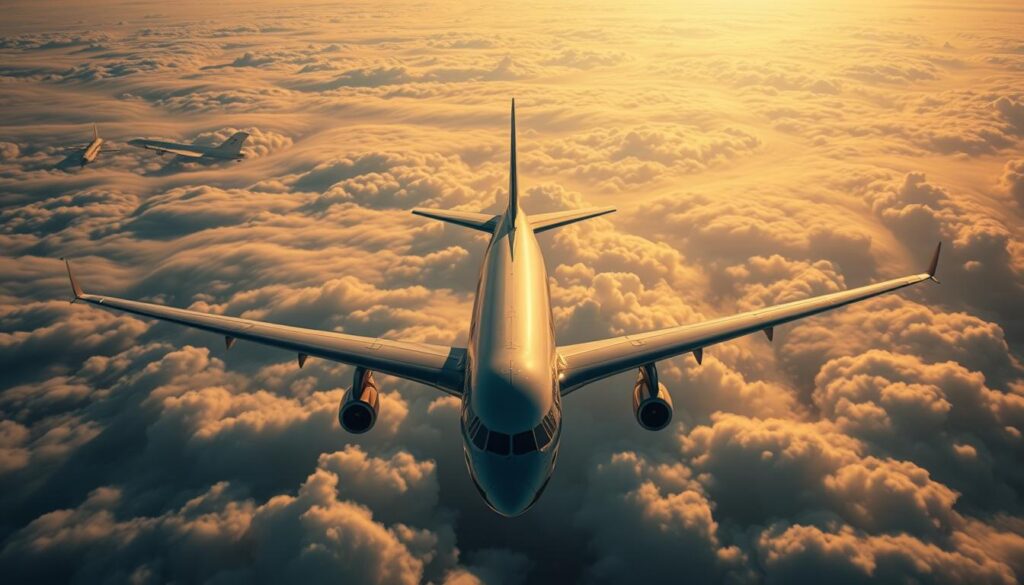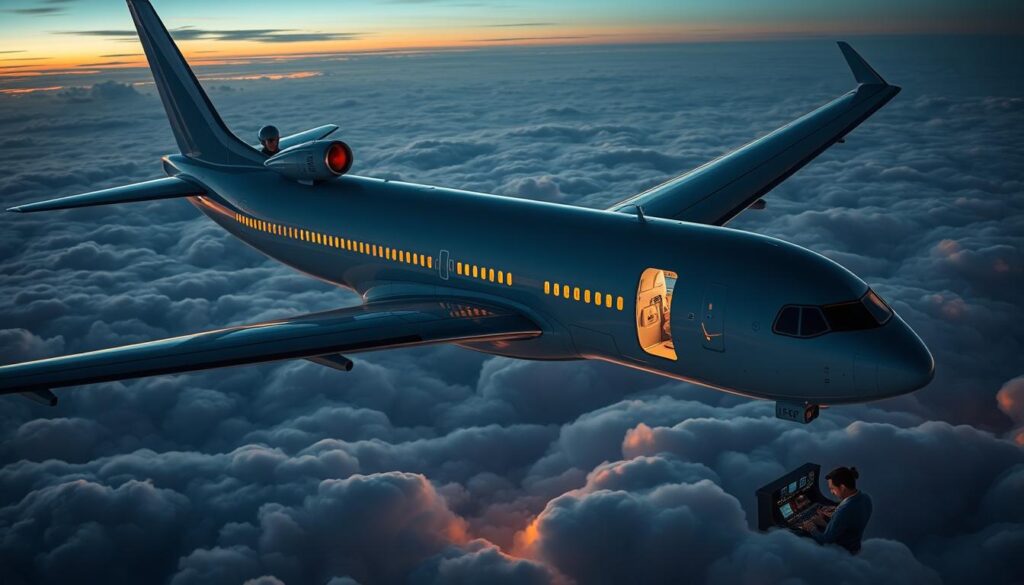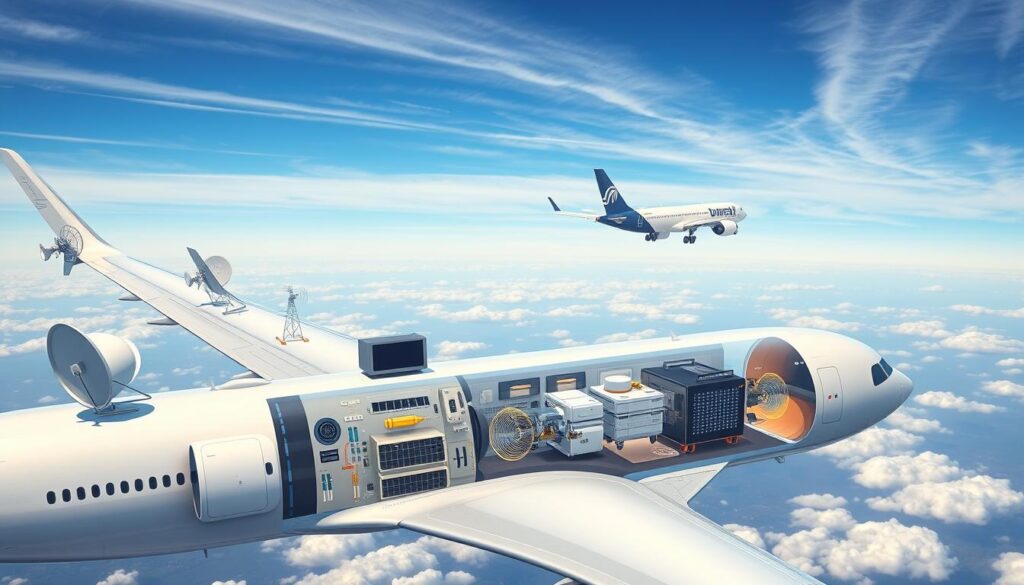In-Flight Wi-Fi: How It Works and What to Expect
Staying connected during flights has become a necessity for many travelers. According to a 2021 survey, 82% of respondents said they would become repeat flyers with an airline if they had a good Wi-Fi experience. This statistic highlights the growing demand for reliable internet connectivity during flights.
Airlines are taking notice, with many adopting free in-flight Wi-Fi to better compete in the market. As a result, the aviation industry is evolving to meet the needs of its tech-savvy passengers. Understanding how this technology works and what to expect can enhance your flying experience.
The Evolution of Connectivity at 35,000 Feet
At 35,000 feet, the evolution of connectivity has redefined the flying experience. Just a few years ago, having Wi-Fi on a plane was unimaginable, but now it’s become a standard expectation for many travelers.
The journey to this state of connectivity has been remarkable. From the early days of slow and unreliable connections to the current high-speed internet services, in-flight Wi-Fi has come a long way. Airlines have invested heavily in upgrading their systems to meet the growing demand for internet access, transforming the way passengers spend their time on flights.

Today, passengers can stay connected with family and friends, work on projects, or enjoy their favorite shows and movies, all while flying over vast oceans. This connectivity at 35,000 feet has opened up new possibilities for productivity and entertainment, making long flights more manageable and enjoyable.
In-Flight Wi-Fi: How It Works and What to Expect
In-flight Wi-Fi is no longer a luxury, but a necessity for many travelers, and here’s what you need to know. Airplane Wi-Fi, also known as in-flight Wi-Fi, is a wireless internet service provided on commercial airplanes, allowing passengers to connect their Wi-Fi-enabled devices to the internet.
This connectivity enables passengers to watch movies, browse websites, catch up on work, and send messages. The technology behind in-flight Wi-Fi is complex, involving a combination of satellite and air-to-ground connectivity systems.
How In-Flight Wi-Fi Works
In-flight Wi-Fi operates through two primary systems: satellite connectivity and air-to-ground connectivity. Satellite connectivity involves communicating with satellites orbiting the Earth, which then connect to the global internet network. Air-to-ground connectivity, on the other hand, uses cell towers on the ground to provide internet access.

Most modern commercial aircraft are equipped with one or both of these systems, allowing passengers to access the internet during flight. The quality and speed of the connection can vary depending on the type of system used, the aircraft’s location, and the number of users connected.
What to Expect from In-Flight Wi-Fi
When using in-flight Wi-Fi, passengers can expect varying levels of service quality. Some airlines offer high-speed internet, suitable for streaming and video conferencing, while others may provide more basic connectivity for browsing and email.
Understanding what to expect from in-flight Wi-Fi can help manage your expectations and plan your in-flight activities accordingly. Whether you’re looking to stay productive or entertained, in-flight Wi-Fi has become an essential service for air travelers.
Types of In-Flight Wi-Fi Systems Across Major Airlines
There are primarily two types of Wi-Fi systems used by airlines for in-flight internet access. Understanding these systems can help passengers know what to expect from their in-flight internet experience.
The first type is air-to-ground Wi-Fi, which connects to cell towers on the ground. This technology is similar to how cellular networks provide internet access on the ground. Air-to-ground Wi-Fi is generally faster and more reliable over land, making it suitable for domestic flights or routes that primarily fly over land.

The second type is satellite-based Wi-Fi, which uses orbiting satellites to provide internet access. This system is particularly useful for international flights that cross oceans or fly over remote areas where cell towers are not available. Satellite-based Wi-Fi offers broader coverage, including over oceans and remote land areas, but it can be affected by the satellite’s capacity and the signal’s latency.
Major airlines have adopted one or both of these technologies to provide in-flight Wi-Fi. For instance, some airlines use air-to-ground Wi-Fi for domestic flights, while others rely on satellite-based Wi-Fi for international routes. The choice between these systems depends on the airline’s route network, the technology’s availability, and the cost.
Understanding the type of Wi-Fi system used by an airline can help set expectations for the in-flight internet experience. While air-to-ground Wi-Fi may offer faster speeds, satellite-based Wi-Fi provides wider coverage. As technology continues to evolve, we can expect improvements in both types of systems, enhancing the overall in-flight internet experience.
Performance Expectations: Speed, Reliability, and Limitations
In-flight Wi-Fi has come a long way, but its performance can vary widely based on several key factors. Understanding these factors is crucial for managing expectations and making the most out of your in-flight internet experience.
Aircraft Location and Route
The location and route of the aircraft play a significant role in determining the quality of the Wi-Fi connection. Flights over remote or oceanic areas often experience weaker signals due to the distance from cellular towers or satellites.
Number of Connected Users
The number of passengers connected to the in-flight Wi-Fi network can significantly impact its speed and reliability. More users mean a shared bandwidth, potentially leading to slower internet speeds.
Weather conditions can also affect in-flight Wi-Fi performance. Inclement weather can interfere with satellite signals, leading to a less reliable connection.
The speed of in-flight Wi-Fi can range from 32 to 195 Mbps per aircraft, depending on the system and provider. However, the actual speed experienced by passengers can be influenced by the factors mentioned above. Being aware of these limitations can help set realistic expectations for your in-flight internet experience.
By understanding the factors that influence in-flight Wi-Fi performance, passengers can better navigate the limitations and make the most of their connectivity during flights.
Making the Most of Your In-Flight Internet Experience
Making the most of in-flight internet requires some preparation and knowledge of how to optimize your device for the best experience. To start, it’s a good idea to check your airline’s Wi-Fi offerings and route coverage before your flight.
Optimizing Your Device for in-flight Wi-Fi involves a few simple steps. First, ensure your device is set to airplane mode with Wi-Fi enabled. Then, adjust your device settings to prevent automatic updates or background data usage.
When using in-flight internet, it’s advisable to avoid streaming high-definition videos, as this can quickly consume your data allowance and may not be supported by the in-flight Wi-Fi network. Instead, consider downloading necessary content before your flight or opting for lower resolution streaming.
Managing Data Usage is crucial to making the most of in-flight internet. Be mindful of your data consumption by limiting activities that require high bandwidth. Use email, messaging apps, and browse the web in a way that keeps your data usage in check.
By following these tips, you can enjoy a more productive and entertaining flight. In-flight internet can significantly enhance your travel experience, making it more enjoyable and productive.
Conclusion
In-flight Wi-Fi has transformed the way we experience air travel, enabling passengers to stay connected, productive, and entertained at 35,000 feet. As discussed, the technology behind in-flight Wi-Fi involves complex systems that provide internet access via satellite or air-to-ground connectivity.
Major airlines have adopted different types of in-flight Wi-Fi systems, offering varying levels of speed and reliability. Understanding these differences is crucial for passengers to make informed decisions about their in-flight internet experience.
As technology continues to evolve, we can expect even faster and more reliable in-flight Wi-Fi. This advancement will further enhance the travel experience, allowing passengers to stay connected with family, friends, and colleagues while flying. The future of in-flight Wi-Fi is promising, and its impact on air travel will be significant.
